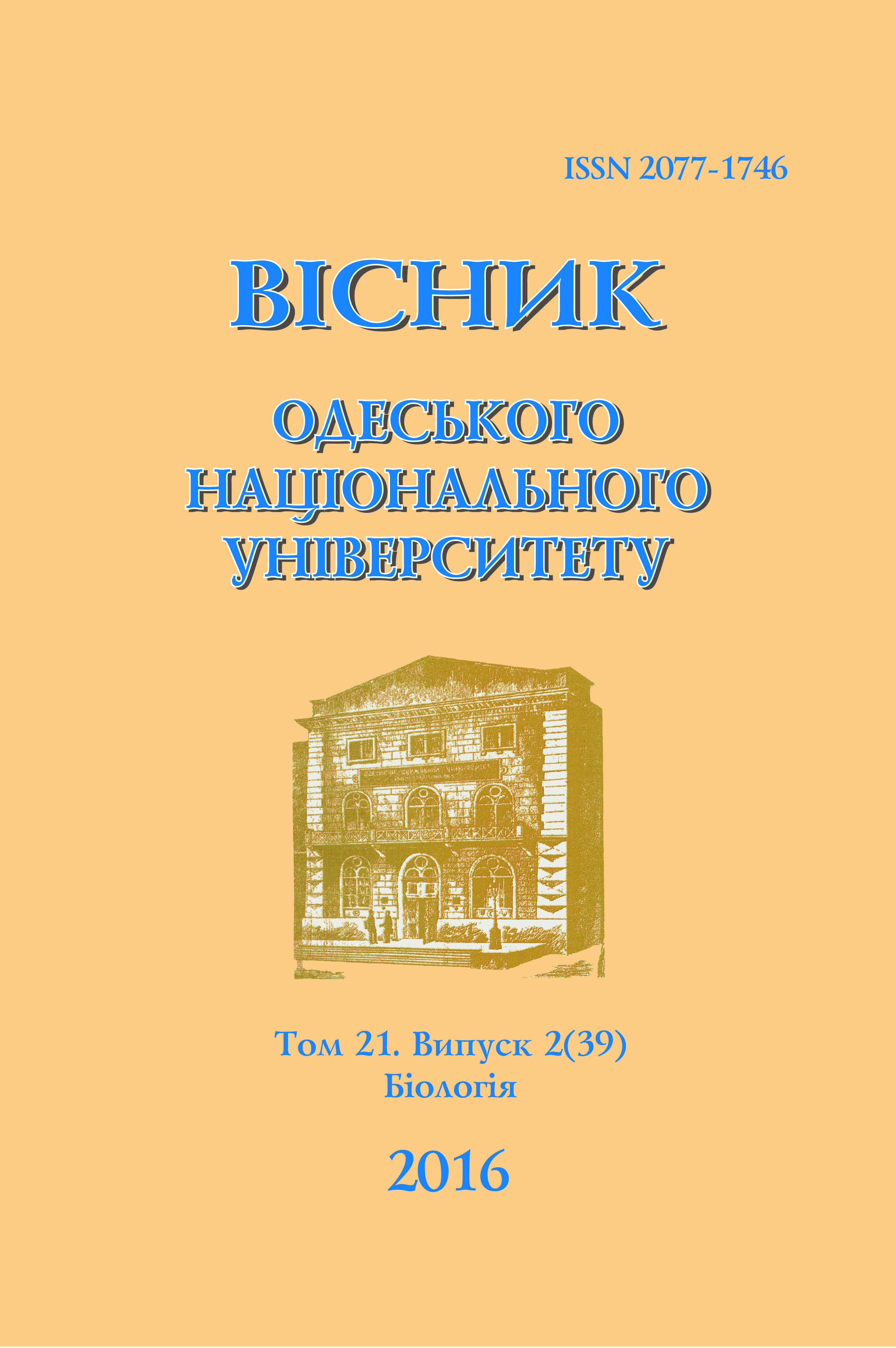ВІДМІННОСТІ У МІЖВИДОВІЙ АГРЕСІЇ МУХОЛОВКИ БІЛОШИЇ (FICEDULA ALBICOLLIS) ТА МУХОЛОВКИ СІРОЇ (MUSCICAPA STRIATA) НА МІСЦЯХ ВОДОПОЮ
DOI:
https://doi.org/10.18524/2077-1746.2016.2(39).72176Ключові слова:
поведінка, міжвидова та внутрішньовидова агресія, Muscicapidae, водопій.Анотація
Робота присвячена дослідженню співвідношення міжвидових та внутрішньовидових контактів мухоловки білошиї (Ficedula albicollis) та мухоловки сірої (Muscicapa striata) у природних та антропогенно навантажених територіях лісостепової зони України. Серед них відсотково переважають міжвидові, особливо агресивні, взаємодій, що вказує на важливість встановлення просторової структури. Частка внутрішньовидових зустрічей та агресії більше у природі, міжвидова агресія збільшується із появою антропогенного фактора. Успіх таких контактів забезпечує виправдання енергетичних затрат на агресивні взаємодії. Зазначено перелік видів, на які мухоловки реагують агресивно
Посилання
Ivanitskiy VV (1982) “Ethological aspects of relationship between close animal species” [“Etologicheskie aspektyi vzaimootnosheniy mezhdu blizkimi vidami zhivotnyih”], Zoological journal, № 61, 10, pp 1461-1471.
Ivannitskiy VV (1980) “Interspesific relationship sympatric species heaters (Oenanthe, Turdidae, Passeriformes). The behavioral aspects of coexistence of similar species” [“Mezhvidovyie otnosheniya simpatricheskih vidov kamenok (Oenanthe, Turdidae, Passeriformes). Povedencheskie aspektyi sosuschestvovaniya blizkih vidov”] Zoological journal, № 59, 5, pp 739-749.
Panov EN (1978) “Mechanisms of communications in birds” [“Mehanizmy kommunikacii u ptic”], Moscov: Science, 304 p.
Panov EN, Ivanitskiy VV (1975) “The interspecific territorial relations in the mixed population of Finsch's Wheatear Oenanthe finchi and pied wheatea O. pleschanka on the peninsula of Mangyshlak” [“Mezhvidovyie territorialnyie otnosheniya v smeshannoy populyatsii chernobokoy kamenki Oenanthe finchi i kamenki-pleshanki O. pleschanka na poluostrove Mangyishlak”], Zoological journal, № 54, 9, pp 1357-1370.
Panov EN, Ivanitskiy VV (1979) “Spatial relationship of four types of shrikes in the Southern Turkmenistan” [“Prostranstvennyie vzaimootnosheniya chetyireh vidov sorokoputov v Yuzhnoy Turkmenii”], Zoological journal, № 58, 10, pp 1518-1535.
Popov SV, Ilchenko OG (2008) “Methodical recommendations about ethological supervision over mammals in slavery’’ [“Metodicheskie rekomendatsii po etologicheskim nablyudeniyam za mlekopitayuschimi v nevole”], Moskov: Moskovskiy zoopark, 165 p.
Ryabitsev VK (1977) “Results of research of the interspecific territorial relations of birds on the Southern Yamal” [“Rezultatyi issledovaniya mezhvidovyih territorialnyih otnosheniy ptits na Yuzhnom Yamale“], Zoological journal, № 56, 2, pp 232–242.
Semaho N (2011) “Spotted flycatcher” [“Mukholovka sira”], Bulletin "Bird", № 2. pp 1.
Arnott G, Elwood RW (2009) “Assessment of fighting ability in animal contests”, Anim. Behav., Vol. 77, pp 991-1004.
Briefer E, Rybak F, Aubin T (2008) “When to be a dear enemy: flexible acoustic relationships of neighbouring skylarks, Alauda arvensis”, Anim. Behav. Vol. 76, pp 1319-1325.
Colléter M, Brown С (2011) “Personality traits predict hierarchy rank in male rainbowfish social groups”, Animal Behaviour, Vol. 81, 6, pp 1231–1237.
Dingemanse NJ, de Goede P (2004) “The relation between dominance and exploratory behavior is context-dependent in wild great tits”, Behavioral Ecology, Vol. 15, 6, pp 1023–1030.
Foltz, SL, Ross, AE, Laing BT (2015) “Get off my lawn: increased aggression in urban song sparrows is related to resource availability”, J. Behavioral Ecology, Vol. 25, pp 871-884.
Forsman JT, Hjernquist MB., Taipale J, Gustafsson L (2007) “Competitor density cues for habitat quality facilitating habitat selection and investment decisions”, Behavioral Ecology, Vol. 19, 3, pp 539-545.
Forsman JT, Thomson RL, Seppänen JT (2007) “Mechanisms and fitness effects of interspecific information use between migrant and resident birds”, J. Behavioral Ecology, Vol. 18, 5, pp.888-894.
Grether GF, Losin N, Anderson CN, Okamoto K (2009) “The role of interspecific interference competition in character displacement and the evolution of competitor recognition”, Biological Reviews, Vol. 84, pp 617–635.
Grether GF, Anderson CN, Drury JP, Kirschel AN, Losin NG, Okamoto, Peiman KS (2013) “The evolutionary consequences of interspecific aggression” , Annals of the New York Academy of Sciences, Vol. 1289, pp 48-68.
Jaakkonen T, Kivela SM, Meier CM, Forsman JT (2016) “The use and relative importance of intraspecific and interspecific social information in a bird community”, Behavioral Ecology, Vol. 26, 1, pp 55–64.
Lehtonen TK, McCrary JK, Meyer A (2010) “Territorial aggression can be sensitive to the status of heterospecific intruders”, Behav. Process, Vol. 84, pp 598-601.
Martin PR, Martin TE (2001) “Ecological and fitness consequences of species coexistence: a removal experiment with wood warblers”, Ecology, Vol. 82, pp 189-206.
Peiman KS, Robinson BW (2010) “Ecology and evolution of resource-related heterospecific aggression”, Q. Rev. Biol., Vol. 85, pp 133-158.
Reichert MS, Gerhardt HC (2014) “Behavioral strategies and signaling in interspecific aggressive interactions in gray tree frogs” , Behavioral Ecology, Vol. 25, 3, pp 520-530.
Rosell F, Gundersen G, Le Galliard JF (2008) “Territory ownership and familiarity status affect how much male root voles (Microtus oeconomus) invest in territory defence”, Behav. Ecol. Sociobiol., Vol. 62, pp 1559-1568.
Tanner CJ, Adler FR (2009) “To fight or not to fight: context-dependent interspecific aggression in competing ants”, Anim. Behav., Vol. 77, pp 297-305.
Temeles EJ(1994) “The role of neighbors in territorial systems — when are they dear enemies”, Anim. Behav., Vol. 47, pp 339-350.
Weiß BM, Kotschal K, Foerstera K (2011) “A longitudinal study of dominance and aggression in greylag geese (Anser anser)”, Behavioral Ecology, Vol. 22, 3, pp 616–624.
Eason P, Hannon SJ (1994) “New birds on the block — new neighbors increase defensive costs for territorial-male willow ptarmigan”, Behav. Ecol. Sociobiol., Vol. 34, pp 419-426.
##submission.downloads##
Опубліковано
Як цитувати
Номер
Розділ
Ліцензія
Авторське право (c) 2016 Вісник Одеського національного університету. Біологія

Ця робота ліцензується відповідно до Creative Commons Attribution-NonCommercial 4.0 International License.
Автори, які публікуються у цьому журналі, погоджуються з наступними умовами:
- Автори залишають за собою право на авторство своєї роботи та передають журналу право першої публікації цієї роботи на умовах ліцензії Attribution-NonCommercial 4.0 International (CC BY-NC 4.0).
- Автори мають право укладати самостійні додаткові угоди щодо неексклюзивного розповсюдження роботи у тому вигляді, в якому вона була опублікована цим журналом (наприклад, розміщувати роботу в електронному сховищі установи або публікувати у складі монографії), за умови збереження посилання на першу публікацію роботи у цьому журналі.
- Політика журналу дозволяє і заохочує розміщення авторами в мережі Інтернет (наприклад, у сховищах установ або на особистих веб-сайтах) роботи, оскільки це сприяє виникненню продуктивної наукової дискусії та позитивно позначається на оперативності та динаміці цитування опублікованої роботи (див. The Effect of Open Access).
Публікація праць в Журналі здійснюється на некомерційній основі. Комісійна плата за оформлення статті не стягується.

